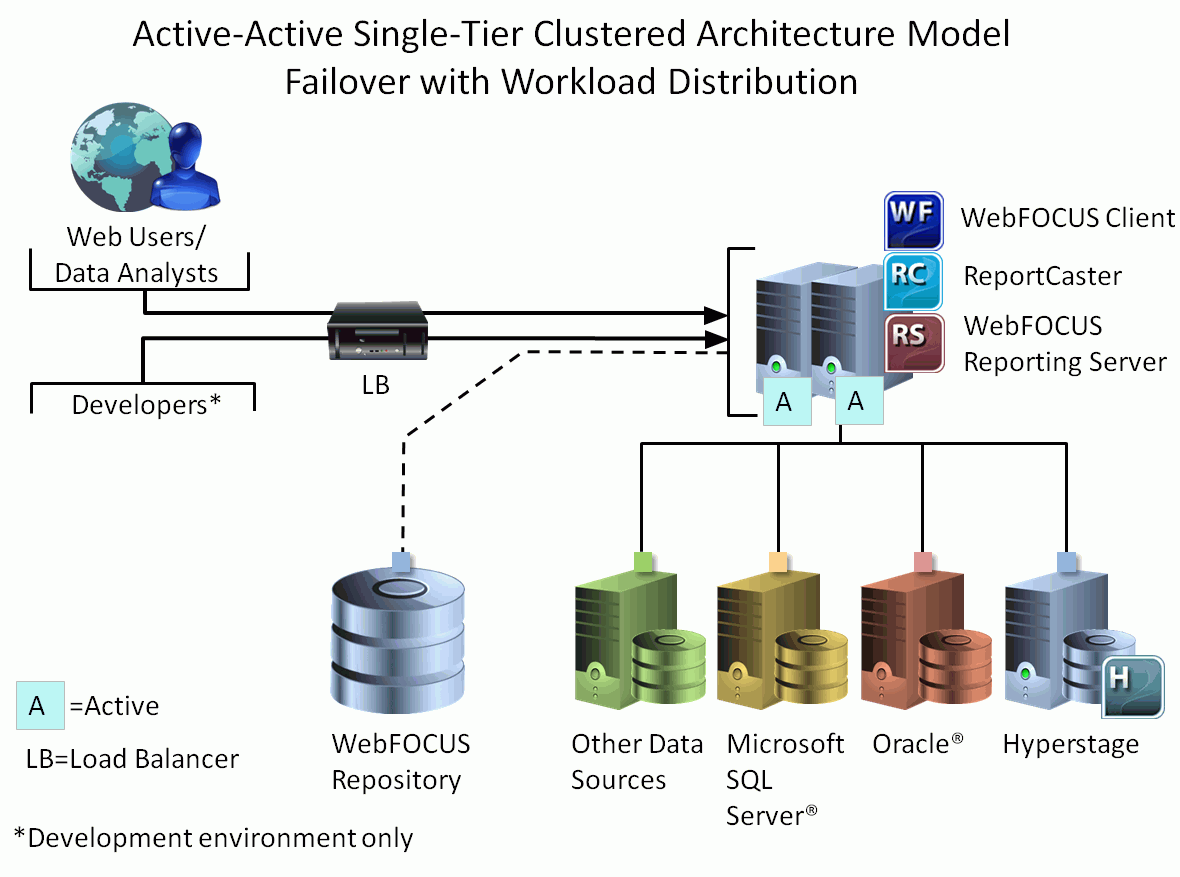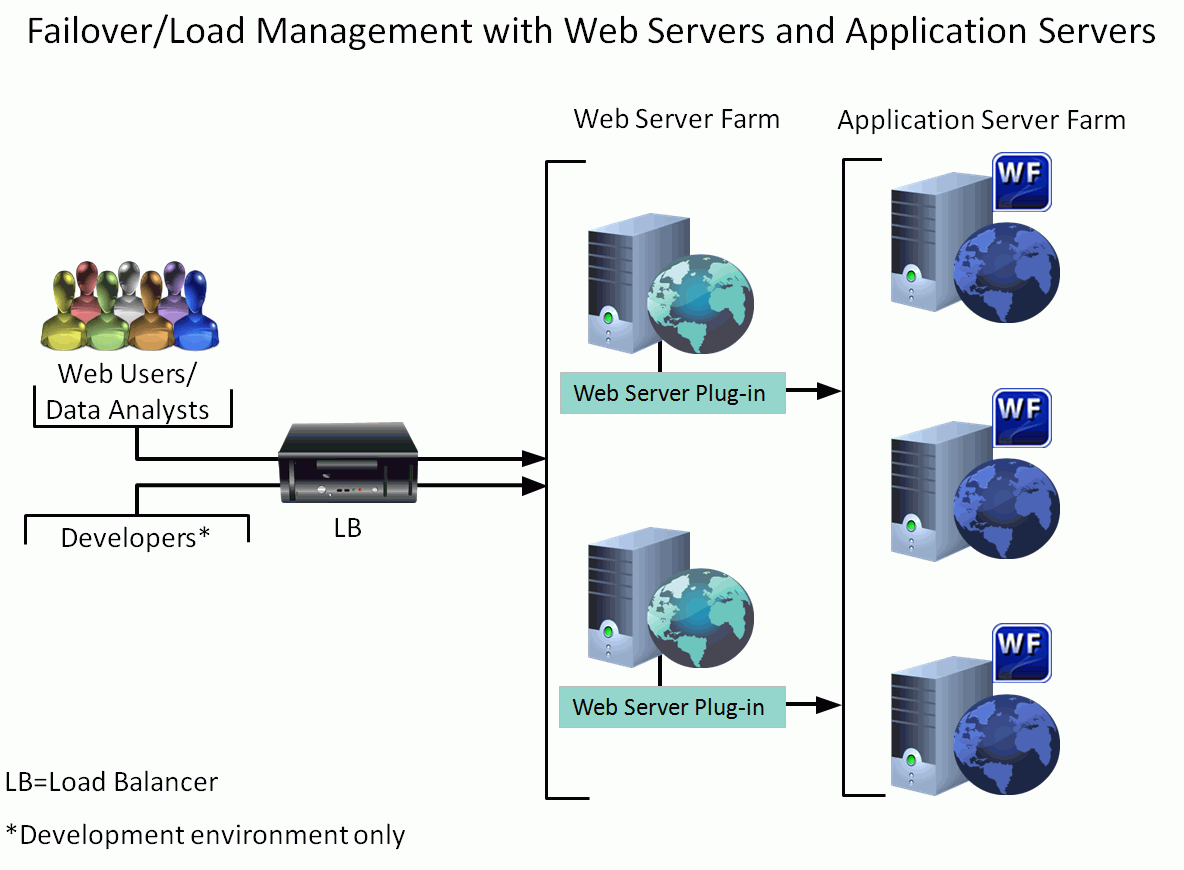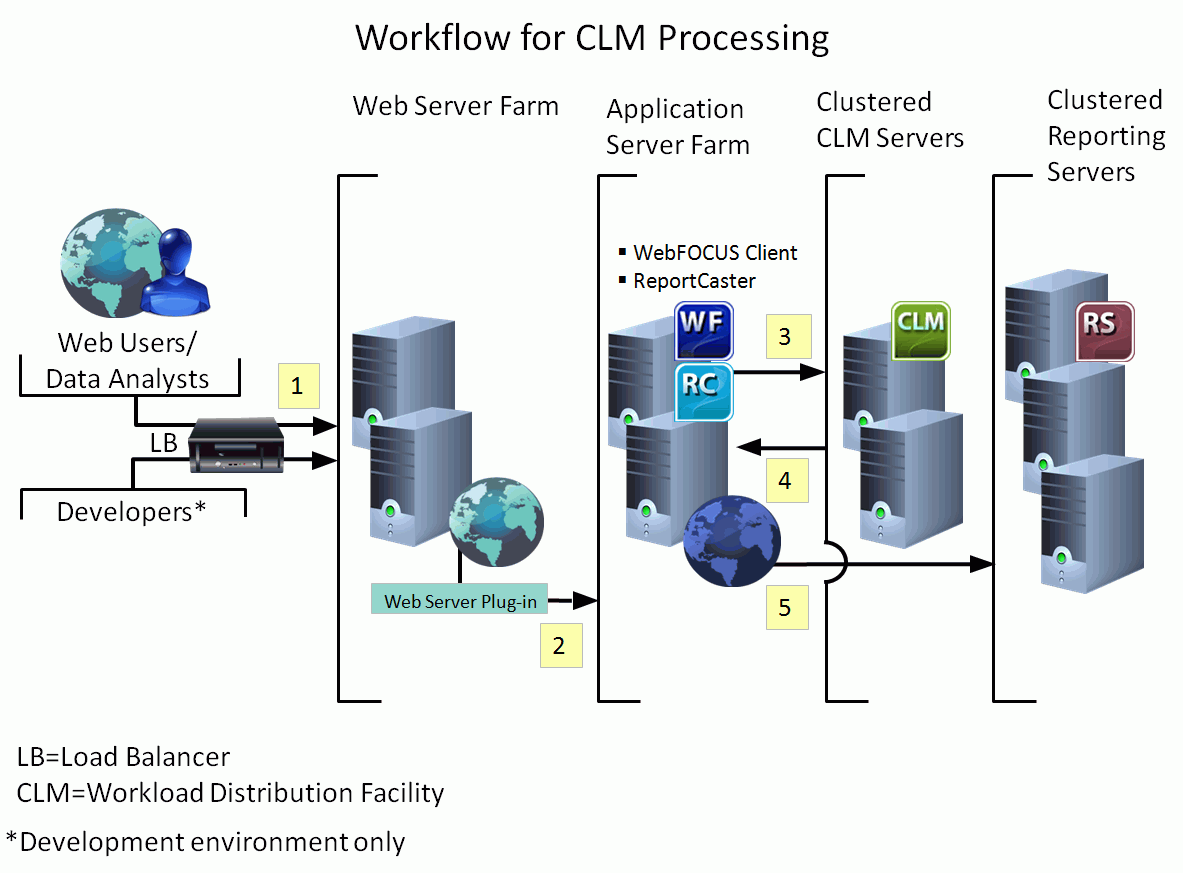High availability, failover, and load management can
be implemented at several components:
There are two main types of schemes to support high availability,
failover, and load management schemes:
In the following sections we will take a look at how these schemes
can be implemented with WebFOCUS for the components listed earlier.
x
The following images illustrate how hardware can be
configured to support the commonly used Active-Active load management
schemes to support the clustered architecture models covered in Designing the WebFOCUS 8 Architecture.
We make reference to the Presentation Layer, which is comprised
of the WebFOCUS Client and ReportCaster, and the Reporting and Metadata
Layer, which is comprised of the Reporting Server.
This section is not intended to cover high availability and failover
at the WebFOCUS Application Level. Later on we will cover how WebFOCUS
Workload Distribution Facility (CLM) can be used to provide high
availability and failover at the WebFOCUS Application Level.
Note: Third-party resources that are required to support
the clustered architecture models must also support high-availability.
In the following Active-Active Single-Tier Clustered Architecture
Model image:
- There are two machines,
both in active mode.
- Each machine hosts
both the Presentation and Reporting and Metadata Layers.
- Provides high availability
and failover at the machine level.
- For active machines:
- Both machines are
actively listening for incoming requests and will process all requests
concurrently.
- If one of the machines
become unavailable, all requests will be routed to the remaining
machine.

In the following Active-Active Multi-Tier Clustered Architecture
Model image:
- There are two machines,
each hosting the Presentation Layer.
- There are three machines,
each hosting the Reporting and Metadata Layer.
- Provides high availability
and failover at the machine level for both Presentation and Reporting
and Metadata Layers.
-
Presentation Layer. Active
machines. Both machines are actively listening for incoming requests
and will process all requests concurrently.
-
Reporting and Metadata Layer. Active
machines. All requests will be routed to all three machines, each
of which are actively listening for incoming requests and will process
all requests concurrently.

Maintaining Performance When Cluster Members Become Unavailable
There must be adequate resources to support desired load in the
event one or more cluster members become unavailable. Companies
must establish policy as to what constitutes acceptable degradation.
For example, if you have a cluster of two Reporting Servers running
at 75% capacity, and one goes offline, the workload of the remaining
Reporting Server will be increased potentially resulting in performance
degradation. To maintain the same performance of the system as when
running at full capacity, consider increasing the capacity of the
remaining Reporting Server or adding a third Reporting Server node.
Considerations for Web Servers and Java Application Servers
Web server farms can be fronted by load balancers to support
load management and failover schemes, as shown in the following
image.

In the Failover/Load Management image, a load balancer routes
user requests to the web servers in the web server farm using a
defined dispatch algorithm. Each web server in the Web Server Farm
is installed with a web server plug-in to communicate to the application servers
in the Application Server Farm that are hosting WebFOCUS. The web
server plug-in has a default dispatch algorithm.
There are special considerations for web servers and application
servers, which are described below.
Fronting the Application Server With a Web Server
Often, we are asked, "Do we need a web server and an application
server?" While WebFOCUS will work with both a web server and application
server, or only an application server that has a built-in HTTP server,
it is best to design an architecture using web servers working in
tandem with application servers for WebFOCUS usage.
A web server primarily serves up static and dynamic pages from
HTTP requests. It does not support transactions, database connection
pooling, servlet, or JavaServer™ Pages (JSP) files, and will typically
pass such requests to a server-side program that can handle it,
such as a servlet container. WebFOCUS consists of web applications
that are comprised of related files, including HTML files, JavaServer
Pages files, and servlets.
Some of the advantages in fronting a application server with
a web server are outlined below:
-
Content. Separate
content, in that you can have the web server serve up static pages and
images so that some of the burden on the application server is reduced.
-
Scalability. By
placing a web server in front of the application server, you can
use the load balancing features of the web server and plug-ins to
distribute the workload among several application servers.
-
Security. Placing
a web server in front of the application server provides an additional level
of filtering and security that can be integrated with SSO policy
agents of security authentication providers, such as CA SiteMinder.
x
Customers can leverage the built-in failover and load
management capabilities of WebFOCUS to minimize application downtime
and distribute workload to maintain optimal performance. These capabilities
are implemented for the following WebFOCUS components.
-
Workload Distribution Facility. The
Cluster Manager (CLM) works in tandem with the Presentation Layer
to distribute workload across a cluster of WebFOCUS Reporting Servers.
-
ReportCaster Workload Distribution. The
Workload Manager distributes scheduled jobs across a cluster of
Distribution workers.
Let us first take a look at how these components are designed
to work and how they can be best used to satisfy failover and workload
distribution requirements using supported load-management schemes.
x
Workload Distribution Facility
The Workload Distribution Facility (CLM) is an independent
server component that manages one or more clusters of WebFOCUS Reporting
Servers. You can have one CLM or a cluster of CLMs running at the
same time in Active-Active mode. To leverage CLM, you need to configure
the Presentation Layer to communicate to one or a cluster of CLMs.
It is recommended to use a cluster of CLMs for high availability
and failover.
The main functions of the CLM are to:
- Use collected
polling statistics to determine which remote WebFOCUS Reporting Servers
a WebFOCUS request should be routed. CLM sends this information
to the Presentation Layer, which will forward the user request to
the recommended server.
- Maintain attributes
for each remote WebFOCUS Reporting Server.
- Monitor all of the
remote WebFOCUS Reporting Servers through a central console.
- Define rules for
monitoring and dispatching requests to the remote WebFOCUS Reporting
Servers.
- Log statistics about
remote WebFOCUS Reporting Servers for reporting and subsequent analysis.
x
Workflow for CLM Processing
When a user submits a request to the Presentation Layer,
the high-level workflow for processing that request is outlined,
as shown in the following image.

- Request
is submitted and routed through the load balancer to a web server.
- Request is sent from
the web server to the application server, where the WebFOCUS Client
or ReportCaster is installed.
- WebFOCUS Client or
ReportCaster asks CLM for the remote WebFOCUS Reporting Server to
which the request should be sent.
- CLM uses collected
polling statistics to determine the most appropriate remote WebFOCUS
Reporting Server to process the request, and notifies the WebFOCUS
Client or ReportCaster.
- The WebFOCUS Client
or ReportCaster sends the request to the specified WebFOCUS Reporting
Server.
x
ReportCaster Workload Distribution
When ReportCaster is configured for Workload Distribution,
the Workload Manager is activated on the ReportCaster Distribution
Server. The Workload Manager distributes scheduled jobs to a cluster
of Workers for processing. This provides a scalable way to process
a larger number of scheduled jobs. CLM and ReportCaster Workload
Distribution can be configured to work in tandem to manage the workload.
Note: ReportCaster supports Active-Passive failover for
the ReportCaster Distribution Servers. There can only be a single
Primary ReportCaster Distribution Server in a WebFOCUS instance.
If the Primary ReportCaster Distribution Server becomes unavailable,
then the roles are switched and the Failover ReportCaster Distribution
Server is automatically brought online and becomes the Primary ReportCaster
Distribution Server. ReportCaster supports Active-Active failover
and load management for the Workload Distribution Workers.
x
Configuring WebFOCUS for High Availability, Failover, and Load Management
The following is the recommended order for configuring
WebFOCUS to support high availability, failover, and load management.
- WebFOCUS Reporting
Servers.
- Cluster JSCOM agents
under Java Services.
- Create Data Services
on each WebFOCUS Reporting Server.
Workload Distribution Facility (CLM)
- Install
a cluster of CLMs. For each installation of the Workload Distribution
Facility (CLM):
- Enable the Cluster
Manager (CLM).
- Assign values to
CLM properties.
- Add Active Remote
Server nodes and assign values for Remote Server properties.
- Create a CLUSTER
node called EDASERVE and assign values for Remote Server properties.
- Create additional
CLUSTER nodes if the configuration requires multiple clusters and assign
values for Remote Server properties.
- Assign Remote Servers
to each of the CLUSTER nodes.
WebFOCUS Client
- Create CLM Processing
nodes to match the CLM CLUSTER nodes created on the CLM. The WebFOCUS
Client has to be configured to communicate to one or more clusters defined
on the CLM.
- Convert the default
Client node, EDASERVE, to be a CLM Processing node.
- Create a separate
CLM Processing node for each additional CLM CLUSTER node, using identical
names. For example, if the CLM CLUSTER node is called UNIXCLUS,
then the name of the CLM Processing node must also be UNIXCLUS.
Assign values for properties.
- If using a cluster
of CLMs, add each CLM to the CLM Processing node using the Add option.
ReportCaster
As of WebFOCUS Release 8.1 Version 03, ReportCaster leverages
the WebFOCUS Client communications file, odin.cfg. You no longer
have to create Data Servers in the ReportCaster configuration GUI.
Instead, when you click New from the ReportCaster configuration
GUI, the list of Client, CLM Processing, and Cluster nodes defined
on the WebFOCUS Client will display. You can then choose the appropriate
nodes that are required for ReportCaster scheduling.
The recommendation is to select all listed nodes because at the
time when the schedule is being created, a check is not done to
ensure that the assigned server for the resource being scheduled
is available to ReportCaster. If the assigned server is not available
to the Primary ReportCaster Distribution Server, the scheduled job
will fail when it is executed. This capability is being evaluated
for a future release.



